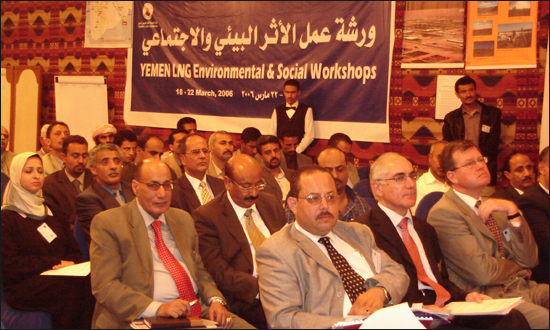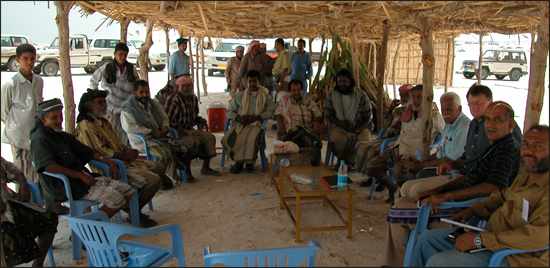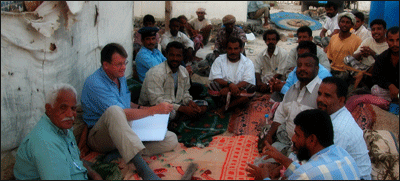 Public Consultation & Disclosure Background and Strategy
Public consultation and disclosure has played and continues to play a vital role in the management of Yemen LNG’s relationship with key stakeholders. Yemen LNG has created forums for discussion where information relating to the project can be exchanged and where concerns can be raised.
The initial public consultation strategy was developed during 2005 which built upon the consultation work undertaken in the project conceptual stages since 1997. The first stage of this strategy development involved the identification of all relevant stakeholders. This process was conducted with the assistance of Yemeni and international experts with a sound knowledge both of the Project area and the stakeholder identification guidelines in the World Bank Participation Sourcebook.
Relevant stakeholders were considered to be those persons affected by the process and outcomes of the Project, those with influence or those who could provide certain information regarding the process and outcomes, as well as those who were simply interested in the Project and its outcomes. The stakeholder list was carefully developed to create a preliminary stakeholder map, the purpose of which was to identify key groups and key issues raised as well as indicating which groups would be likely to be impacted by the various issues.
From the early days in 1997, with an acceleration following project sanction in August 2005, a wide range of meetings have been held involving stakeholders, including national and local authorities, fishing and other nearby communities and non-governmental organisations operational in Yemen. In August 2005, the first phase of detailed consultation began with communications undertaken in both English or Arabic as appropriate. Representatives from various groups from local communities (ie Project Affected People) to national organisations were included in this process and a number of issues were identified. These issues are listed in detail along with Yemen LNG’s response in the initial Public Consultation and Disclosure Plan (PCDP) which was submitted to the Lending Agencies in June 2007.
In addition, Yemen LNG publicly disclosed its Environmental & Social Impact Assessment (ESIA) in February 2006 on its website. At the same time, the ESIA was publicly disclosed on lenders’ websites. The ESIA was made available for a 60 day comment period in line with the World Bank/International Finance Corporation (IFC) disclosure requirements. In addition to the entire downloadable file, visitors to the Yemen LNG site are able to download the ESIA in much smaller, more manageable sections. Copies of the complete ESIA and copies of the Executive Summary in both Arabic and English were distributed to approximately 230 stakeholders, central and local government authorities, bilateral agencies, multilateral agencies, local and national NGOs, Yemen LNG staff and consultants as well as the media.
Public consultation and disclosure is an interactive process. Yemen LNG commenced this process in 1997 and it continued to actively consult with stakeholders throughout the construction phase (2005 – 2010).
Since the project is now in the operational phase, the PCDP was comprehensively updated in November 2009 and it has since been updated again in November 2010. The purpose of the second PCDP Update has been to identify and discuss Public Consultation and Disclosure (PCD) actions and processes which are continuing during operations. The PCDP Update expands on PCD processes, objectives and actions outlined in the original PCDP issued in 2006 and the first PCDP Update issued in November 2009; particularly identifying the ‘Consultation during Operations’ and the accompanying objectives for consultation undertaken during an operating environment. During the Operations phase, the PCD activities are largely linked to the implementation of the SD Strategy (this website provides further details on the design, focus areas and development fields of the Strategy).
The PCDP commitments identified in the Operations ESMP are also included and supported by a description of the CRSD department which is organised within the YLNG Corporate Affairs Department since the beginning of 2010. Prior to this date it was part of the YLNG Corporate Health, Safety, Social and Environment (HSS&E) Department. CRSD will be responsible for implementation of the PCDP.
A separate PCDP Commitments Register exists to identify actions which achieve compliance with PCD related commitments during construction; and identifies additional commitments from the PCDP for operations. The PCDP and Updates define how YLNG intends to achieve and document compliance with these commitments.
Like the PCDP, the PCDP Update is a “living document” which will be revised over time to reflect the project status, information gained through the PCD process, and the nature of the relationship between Yemen LNG and primary and secondary stakeholders. The PCDP Update outlines PCD activities and processes that have taken place at local levels to address issues relating directly to the impacts of the project on project affected people (PAP) including:
- Identification of project stakeholders and mechanisms for stakeholder feedback and information sharing;
- Ensuring that issues raised by project stakeholders are addressed;
- Identification of the resources required to implement the plan, and development of procedures to monitor implementation; and
- A robust and transparent complaints and grievance mechanism for project stakeholders.

A consultation and disclosure workshop with government stakeholders


Balhaf village representatives meeting with Yemen LNG staff
|